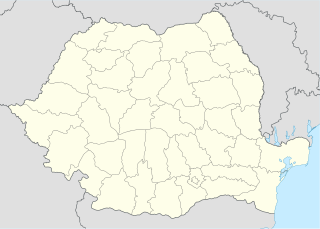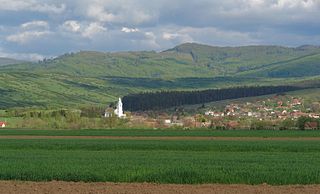
Drăguș is a commune in Brașov County, Romania. It is composed of a single village, Drăguș, part of Viștea Commune until being split off in 2004.

Câmpulung la Tisa is a commune in Maramureș County, northern Romania. It is composed of a single village, Câmpulung la Tisa.

Acâș is a rural municipality of 2,792 inhabitants situated in Satu Mare County, Romania. It is composed of four villages: Acâș, Ganaș (Gánás), Mihăieni (Krasznamihályfalva) and Unimăt (Újnémet).

Berveni is a commune of 3,331 inhabitants situated in Satu Mare County, Romania. It is composed of two villages, Berveni and Lucăceni (Újkálmánd).

Odoreu is a commune of 4,800 inhabitants situated in Satu Mare County, Romania. It is composed of six villages: Berindan (Berend), Cucu, Eteni, Mărtinești (Krasznaszentmárton), Odoreu and Vânătorești (Gombáserdő).

Tiream is a commune of 2,375 inhabitants situated in Satu Mare County, Romania. It is composed of three villages: Portița (Portelek), Tiream and Vezendiu (Vezend).

Vetiș is a commune of 4,475 inhabitants situated in Satu Mare County, Romania. It is composed of three villages: Decebal (Újtelep), Oar (Óvári) and Vetiș.

Răbăgani is a commune in Bihor County, Romania. It is composed of six villages: Albești (Fehérlak), Brătești, Răbăgani, Săliște de Pomezeu (Papmezőszeleste), Săucani (Szokány) and Vărășeni (Veresfalva). It is located about 50 km south of Oradea. It was mostly Hungarian until 1955, when it became equally split 50/50 with the Romanian community. In 2002, it was 94.2% Romanian and 5.7% Roma. The 1% of the population that was Jewish left shortly after World War II.

Tărlungeni is a commune in Brașov County, Romania. It is composed of four villages: Cărpiniș (Kerpenest), Purcăreni (Pürkerec), Tărlungeni and Zizin (Zajzon).

Izvoarele Sucevei is a commune located in Suceava County, Romania. It is composed of three villages: Bobeica, Brodina and Izvoarele Sucevei.

Poiana Blenchii is a commune located in Sălaj County, Romania. It is composed of four villages: Fălcușa (Falkosány), Gostila (Csicsógombás), Măgura (Kishegy) and Poiana Blenchii.

Șicula is a commune in Arad County, Romania, is situated on the southern part of the Teuz Plateau, along the Crişul Alb River. Its surface stretches over 13,130 ha. It is composed of three villages: Chereluș (Kerülős), Gurba (Garba) and Șicula.

Leșu is a commune in Bistrița-Năsăud County, Romania. It is composed of two villages, Leșu and Lunca Leșului.

Maieru is a commune in Bistrița-Năsăud County, Romania. It is composed of two villages, Anieș (Dombhát) and Maieru.

Curtuișeni is a commune in Bihor County, northwestern Romania with a population of 3,780 people. It is composed of two villages, Curtuișeni and Vășad (Érvasad).

Măgești is a commune in Bihor County, northwestern Romania with a population of 2,717 people. It is composed of seven villages: Butani (Rikosd), Cacuciu Nou (Nagykakucs), Dobricionești (Doborcsány), Gălășeni (Gálosháza), Josani (Krajnikfalva), Măgești and Ortiteag (Ürgeteg).

Viișoara is a commune in Bihor County, northwestern Romania with a population of 1,336 people. It is composed of four villages: Izvoarele (Szolnokháza), Pădureni (Erdőtelep), Reghea (Csekenye) and Viișoara.

Crăiești is a commune in Mureș County, Transylvania, Romania. It is composed of four villages: Crăiești, Lefaia (Lefája), Milășel (Kisnyulas) and Nima Milășelului.

Ideciu de Jos is a commune in Mureș County, Transylvania, Romania. It is composed of three villages: Deleni (Oroszidecs), Ideciu de Jos and Ideciu de Sus (Felsőidecs).
Toplița is a commune in Hunedoara County, Romania. It is composed of eight villages: Curpenii Silvașului, Dăbâca (Doboka), Dealu Mic (Párosza), Goleș (Golles), Hășdău (Hosdó), Mosoru (Moszor), Toplița and Vălari (Valár).











